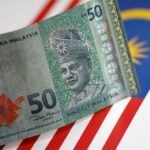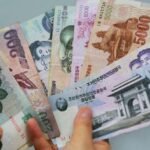You have reached your limit of 5 free articles for this month.
Get Premium without limits for only $479.76 for the first month
Access all our articles, insights, and analysts.

Your coupon code
- GBP/USD stays on the back foot despite upbeat UK PMI data.
- The risk-averse market atmosphere helps the US Dollar hold its ground.
- Investors await S&P Global PMI data from the US.
After closing in negative territory on Tuesday, GBP/USD continued to edge lower and touched its lowest level since July 11 below 1.2880. Although the pair managed to edge higher in the European session, it seems to be having a difficult time gathering recovery momentum.
British Pound PRICE This week
The table below shows the percentage change of British Pound (GBP) against listed major currencies this week. British Pound was the weakest against the Japanese Yen.
| USD | EUR | GBP | JPY | CAD | AUD | NZD | CHF | |
|---|---|---|---|---|---|---|---|---|
| USD | 0.44% | 0.16% | -1.66% | 0.56% | 1.38% | 1.44% | 0.09% | |
| EUR | -0.44% | -0.29% | -2.11% | 0.08% | 0.98% | 0.94% | -0.42% | |
| GBP | -0.16% | 0.29% | -1.95% | 0.36% | 1.27% | 1.22% | -0.15% | |
| JPY | 1.66% | 2.11% | 1.95% | 2.28% | 3.15% | 3.10% | 1.70% | |
| CAD | -0.56% | -0.08% | -0.36% | -2.28% | 0.90% | 0.87% | -0.49% | |
| AUD | -1.38% | -0.98% | -1.27% | -3.15% | -0.90% | -0.04% | -1.40% | |
| NZD | -1.44% | -0.94% | -1.22% | -3.10% | -0.87% | 0.04% | -1.31% | |
| CHF | -0.09% | 0.42% | 0.15% | -1.70% | 0.49% | 1.40% | 1.31% |
The heat map shows percentage changes of major currencies against each other. The base currency is picked from the left column, while the quote currency is picked from the top row. For example, if you pick the British Pound from the left column and move along the horizontal line to the US Dollar, the percentage change displayed in the box will represent GBP (base)/USD (quote).
The data from the UK showed that the S&P Global/CIPS Composite PMI improved to 52.7 in July’s flash estimate from 52.3 in June, highlighting an ongoing expansion in the private sector’s business activity at an accelerating pace.
Assessing the survey’s findings, “policymakers will likely take a cautious approach to loosening policy amid signs of inflationary pressures pivoting away from services towards manufacturing, where Red Sea shipping delays and higher freight prices are adding to costs again,” said Chris Williamson Chief Business Economist at S&P Global Market Intelligence. “The renewed hiring trend could also add to pay pressures, sustaining some stickiness of inflation in the coming months.”
Despite the upbeat UK PMI data, the risk-averse market atmosphere doesn’t allow GBP/USD to regain its traction. At the time of press, UK’s FTSE 100 Index was down nearly 0.5% on the day and US stock index futures were losing between 0.5% and 0.9%.
Later in the day, S&P Global will release July PMI data for the US. Unless either of the Manufacturing or the Services PMI unexpectedly falls below 50, the US Dollar could preserve its strength and continue to cap the pair’s upside, given the negative shift seen in risk mood.
GBP/USD Technical Analysis
The Relative Strength Index (RSI) indicator on the 4-hour chart declines toward 30, reflecting a buildup of bearish momentum. On the downside, 1.2875-1.2870 (100-period Simple Moving Average (SMA), Fibonacci 38.2% retracement of the latest uptrend) aligns as immediate support before 1.2830 (Fibonacci 50% retracement) and 1.2800 (psychological level, static level).
1.2900 (psychological level, static level) could be seen as first resistance before 1.2940-1.2950 (Fibonacci 23.6% retracement, 50-period SMA).
Pound Sterling FAQs
The Pound Sterling (GBP) is the oldest currency in the world (886 AD) and the official currency of the United Kingdom. It is the fourth most traded unit for foreign exchange (FX) in the world, accounting for 12% of all transactions, averaging $630 billion a day, according to 2022 data. Its key trading pairs are GBP/USD, aka ‘Cable’, which accounts for 11% of FX, GBP/JPY, or the ‘Dragon’ as it is known by traders (3%), and EUR/GBP (2%). The Pound Sterling is issued by the Bank of England (BoE).
The single most important factor influencing the value of the Pound Sterling is monetary policy decided by the Bank of England. The BoE bases its decisions on whether it has achieved its primary goal of “price stability” – a steady inflation rate of around 2%. Its primary tool for achieving this is the adjustment of interest rates. When inflation is too high, the BoE will try to rein it in by raising interest rates, making it more expensive for people and businesses to access credit. This is generally positive for GBP, as higher interest rates make the UK a more attractive place for global investors to park their money. When inflation falls too low it is a sign economic growth is slowing. In this scenario, the BoE will consider lowering interest rates to cheapen credit so businesses will borrow more to invest in growth-generating projects.
Data releases gauge the health of the economy and can impact the value of the Pound Sterling. Indicators such as GDP, Manufacturing and Services PMIs, and employment can all influence the direction of the GBP. A strong economy is good for Sterling. Not only does it attract more foreign investment but it may encourage the BoE to put up interest rates, which will directly strengthen GBP. Otherwise, if economic data is weak, the Pound Sterling is likely to fall.
Another significant data release for the Pound Sterling is the Trade Balance. This indicator measures the difference between what a country earns from its exports and what it spends on imports over a given period. If a country produces highly sought-after exports, its currency will benefit purely from the extra demand created from foreign buyers seeking to purchase these goods. Therefore, a positive net Trade Balance strengthens a currency and vice versa for a negative balance.
- GBP/USD stays on the back foot despite upbeat UK PMI data.
- The risk-averse market atmosphere helps the US Dollar hold its ground.
- Investors await S&P Global PMI data from the US.
After closing in negative territory on Tuesday, GBP/USD continued to edge lower and touched its lowest level since July 11 below 1.2880. Although the pair managed to edge higher in the European session, it seems to be having a difficult time gathering recovery momentum.
British Pound PRICE This week
The table below shows the percentage change of British Pound (GBP) against listed major currencies this week. British Pound was the weakest against the Japanese Yen.
| USD | EUR | GBP | JPY | CAD | AUD | NZD | CHF | |
|---|---|---|---|---|---|---|---|---|
| USD | 0.44% | 0.16% | -1.66% | 0.56% | 1.38% | 1.44% | 0.09% | |
| EUR | -0.44% | -0.29% | -2.11% | 0.08% | 0.98% | 0.94% | -0.42% | |
| GBP | -0.16% | 0.29% | -1.95% | 0.36% | 1.27% | 1.22% | -0.15% | |
| JPY | 1.66% | 2.11% | 1.95% | 2.28% | 3.15% | 3.10% | 1.70% | |
| CAD | -0.56% | -0.08% | -0.36% | -2.28% | 0.90% | 0.87% | -0.49% | |
| AUD | -1.38% | -0.98% | -1.27% | -3.15% | -0.90% | -0.04% | -1.40% | |
| NZD | -1.44% | -0.94% | -1.22% | -3.10% | -0.87% | 0.04% | -1.31% | |
| CHF | -0.09% | 0.42% | 0.15% | -1.70% | 0.49% | 1.40% | 1.31% |
The heat map shows percentage changes of major currencies against each other. The base currency is picked from the left column, while the quote currency is picked from the top row. For example, if you pick the British Pound from the left column and move along the horizontal line to the US Dollar, the percentage change displayed in the box will represent GBP (base)/USD (quote).
The data from the UK showed that the S&P Global/CIPS Composite PMI improved to 52.7 in July’s flash estimate from 52.3 in June, highlighting an ongoing expansion in the private sector’s business activity at an accelerating pace.
Assessing the survey’s findings, “policymakers will likely take a cautious approach to loosening policy amid signs of inflationary pressures pivoting away from services towards manufacturing, where Red Sea shipping delays and higher freight prices are adding to costs again,” said Chris Williamson Chief Business Economist at S&P Global Market Intelligence. “The renewed hiring trend could also add to pay pressures, sustaining some stickiness of inflation in the coming months.”
Despite the upbeat UK PMI data, the risk-averse market atmosphere doesn’t allow GBP/USD to regain its traction. At the time of press, UK’s FTSE 100 Index was down nearly 0.5% on the day and US stock index futures were losing between 0.5% and 0.9%.
Later in the day, S&P Global will release July PMI data for the US. Unless either of the Manufacturing or the Services PMI unexpectedly falls below 50, the US Dollar could preserve its strength and continue to cap the pair’s upside, given the negative shift seen in risk mood.
GBP/USD Technical Analysis
The Relative Strength Index (RSI) indicator on the 4-hour chart declines toward 30, reflecting a buildup of bearish momentum. On the downside, 1.2875-1.2870 (100-period Simple Moving Average (SMA), Fibonacci 38.2% retracement of the latest uptrend) aligns as immediate support before 1.2830 (Fibonacci 50% retracement) and 1.2800 (psychological level, static level).
1.2900 (psychological level, static level) could be seen as first resistance before 1.2940-1.2950 (Fibonacci 23.6% retracement, 50-period SMA).
Pound Sterling FAQs
The Pound Sterling (GBP) is the oldest currency in the world (886 AD) and the official currency of the United Kingdom. It is the fourth most traded unit for foreign exchange (FX) in the world, accounting for 12% of all transactions, averaging $630 billion a day, according to 2022 data. Its key trading pairs are GBP/USD, aka ‘Cable’, which accounts for 11% of FX, GBP/JPY, or the ‘Dragon’ as it is known by traders (3%), and EUR/GBP (2%). The Pound Sterling is issued by the Bank of England (BoE).
The single most important factor influencing the value of the Pound Sterling is monetary policy decided by the Bank of England. The BoE bases its decisions on whether it has achieved its primary goal of “price stability” – a steady inflation rate of around 2%. Its primary tool for achieving this is the adjustment of interest rates. When inflation is too high, the BoE will try to rein it in by raising interest rates, making it more expensive for people and businesses to access credit. This is generally positive for GBP, as higher interest rates make the UK a more attractive place for global investors to park their money. When inflation falls too low it is a sign economic growth is slowing. In this scenario, the BoE will consider lowering interest rates to cheapen credit so businesses will borrow more to invest in growth-generating projects.
Data releases gauge the health of the economy and can impact the value of the Pound Sterling. Indicators such as GDP, Manufacturing and Services PMIs, and employment can all influence the direction of the GBP. A strong economy is good for Sterling. Not only does it attract more foreign investment but it may encourage the BoE to put up interest rates, which will directly strengthen GBP. Otherwise, if economic data is weak, the Pound Sterling is likely to fall.
Another significant data release for the Pound Sterling is the Trade Balance. This indicator measures the difference between what a country earns from its exports and what it spends on imports over a given period. If a country produces highly sought-after exports, its currency will benefit purely from the extra demand created from foreign buyers seeking to purchase these goods. Therefore, a positive net Trade Balance strengthens a currency and vice versa for a negative balance.





















